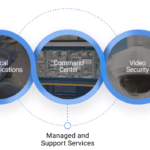EITN: Did Jumio consult the government on framework for National ID. If yes, what are the key areas that Jumio contributed towards?
Frederic: Jumio has not formally been involved with government consultations on the National ID framework. However, as an active participant in the landscape, we are often in touch with various stakeholders including central banks, regulators, and business leaders in this space as part of our day-to-day business and were able to share our inputs through these channels.
In fact, Jumio, together with our partners in Malaysia, recently a hackathon in Malaysia for a digital identity framework category, where we created and demonstrated an identity verification system addressing different use cases relevant to Malaysia — such as securing government aid during COVID-19. As a result of the win, we have also been invited to present our findings and systems to various government bodies.
EITN: What would creating a digital identity mean for Malaysians and businesses?
Frederic: At its crux, having a digital identity streamlines citizens’ interactions with the public and private sector by making sure that everyone can securely operate/transact online, after verifying their identity.
This ability has profound implications. In May, for instance, Indonesia was able to disburse social assistance subsidies to locals after completing a biometric facial authentication systems trial that verifies citizens’ identities. When looking into contact tracing, a digital identity can also smoothly facilitate the process for citizens and help them to check in and out of work, malls, and stores. This is what is currently being done in Singapore.
For businesses, having a robust digital identity system can enable the transformation of their entire operating model — allowing them to verify customers that are signing up for services, facilitate day-to-day transactions, or even allow people to pledge donations. All of this can be done online. This is especially important since citizen movement restrictions have negatively impacted businesses that are dependent on face-to-face customer engagement.
EITN: Why is there a growing need for digital identity verification beyond our current crisis?
Frederic: More than a billion people around the world have no formal way of proving who they are. This is especially true in rural regions that have many undocumented citizens — leading them to struggle in securing basic services, including access to healthcare, education, voting services, and benefit programmes. A unique digital identity for citizens would enable dramatic leaps in accessibility to government services, while pushing for massive quality-of-life and efficiency gains for locals.
It would also help drive financial inclusion — a key priority that would help the last 20% of Malaysians have access to a deposit account. Often, one of the biggest hindrances to reaching unbanked communities is inaccessibility of physical branches, which leads to people not being able to make the trip to a branch to open an account or deal with signup requirements. Opening and maintaining a bank account with nothing more than just your digital identity enables everyone to be included in the financial system. It can also help open up a world of online lending options, including micro-financing, which would allow them to have access to loans that will help the needs of small businesses.
EITN: What are the key ingredients in building a National Digital Identity system?
Frederic: From the government’s perspective, 100% citizen enrolment is an important step to ensure that all locals have equal access to government schemes and services. However, this process can be very challenging for governments to implement.
A way that governments have circumvented this issue is by reducing the friction points to get citizens onboarded. For example, Aadhaar enrolled about 1.2 billion people in India by designing inclusive and flexible documentation requirements and leveraging about 50,000 enrolment points that are accessible even to rural residents. Another approach involves partnering with central banks to access users’ information, which is then placed into a national digital identity initiative. However, these methods come with their own challenges — either through substantial investment, or incomplete central bank databases that do not contain an exhaustive collection of citizen records.
A new way to push past these hurdles lies in the use of the citizen’s own mobile phone to leverage facial biometric identification. This presents a convenient and secure way of capturing biometric data and supporting documents and results in as many citizens being able to be onboarded as possible.
Another important factor is in ensuring that the technologies behind the national digital identity system is running at the highest levels of security. Online crime has increased during the pandemic, as cybercriminals target individuals with phishing emails and social engineering. Governments must ensure that their digital identity systems leverage technologies that go beyond passwords or multi-factor authentication, which can be socially engineered.
It is also crucial to balance security and user friction, so that the technology is easy for citizens to use. This means catering to a wide base of users with differing digital ability. It’s therefore critical for the government to navigate these challenges by deploying the right stack of technology solutions and digital strategies — which may leverage AI, biometrics and liveness detection to deliver faster and more reliable ways to onboard new citizens online and allow them to transact online confidently.
EITN: What are the business considerations before leveraging national digital identity systems?
Frederic: When using national digital identification systems, it is important to understand the level of control that they have in terms of user experience, convenience, and security.
In some cases, this may be the simple issue of evaluating how the system can integrate into the business’ look-and-feel, processes, and system operations. However, it could also involve complicated decisions such as dealing with potential revenue loss. This can arise when there are false positives (when fraudsters manage to log into an account to steal data or complete transactions), or false negatives (when legitimate customers are kept out and can’t complete transactions).
In these instances, businesses have to assess the technologies being used for the national digital identity system in their country, the risk of false positives and negatives, as well as the threat landscape in their market. From there, the regularity and likelihood of such occurrences can be determined, and business leaders can evaluate whether they are comfortable with any potential losses caused by the system. Afterall, it is likely that any costs incurred from a national digital ID framework would be borne by the company (and not the government).
Another consideration is scalability. As national digital identity systems only support citizens from one country, business expansion across markets cannot be efficiently and cost-effectively supported by different systems and technologies. Companies looking to expand may then decide on digital identity verification services with global coverage that can scale with the business.
EITN: What is the best way to implement Malaysia’s National ID system? Do you have comments about how it could integrate with a nation’s border control and immigration system?
Frederic: The best way to implement a National ID system with speed and scale in Malaysia is through a public-private sector joint initiative.
The government already has key citizen data such as ID card numbers, birth certificate information, as well as education and health records that can be aggregated into a national digital identity system. Meanwhile, private sector companies such those in the fintech sector have been making great progress in reaching large swathes of the population to onboard them onto new solutions such as e-payments and digital wallets, with technologies like biometrics.
The Malaysian government can tap into this private sector reach, and value-add to accelerate the pace of digital ID enrolment and adoption. Greater citizen enrolment in national ID also benefits the private sector as it makes onboarding, verification, and fraud detection much easier.
The learnings from national IDs in other countries support this approach. For example, New Zealand experimented with a national identity system by inviting citizens to head down to a local government office and register themselves for the programme. Five years down the line, most citizens still have yet to sign up for the system, since they were not able to see any immediate benefits of digital identities. Some citizens are also concerned about privacy. An initiative in the UK also yielded similar results.
The value of a centralised ID system only kicks in when enrolment levels are high. This makes the programme commercially viable and useful for all stakeholder groups — businesses, citizens, and governments.
A collaborative approach to implementation is also much more secure as multiple parties are involved in validating the same identity. For example, a front-end service provider like Jumio would be responsible for verifying a user’s identity at the point-of-use, while still corroborating the user’s existence with a government-issued ID.
Additionally, most national ID systems do not allow for the integration of foreign IDs at present, limiting the benefit of these systems in the areas of border control and immigration. There are many political factors and issues such as data protection at play that make it difficult for governments to integrate and cross-share such identity information.
In these scenarios, the world will lean towards a document-centric verification approach. It would therefore be ideal if the Malaysian government can establish a good regulatory framework and expand local expertise in dealing with access verification for foreign identities. If Malaysia can get this right, the country will be well-placed to attract investment and also allow local businesses to rapidly grow regionally and internationally.







